
Scoping out possible orchard locations
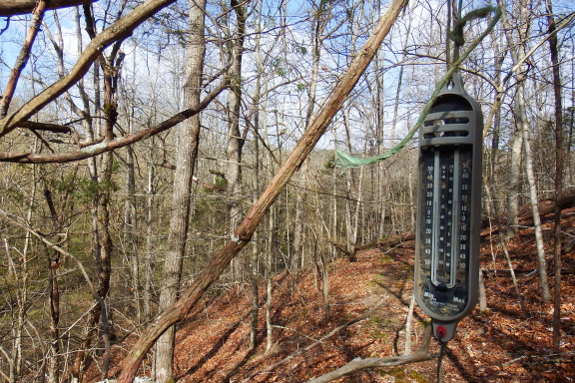
Photos don't lie. I've resorted to voodoo in an effort to get fruit-tree blossoms to bypass spring freezes.
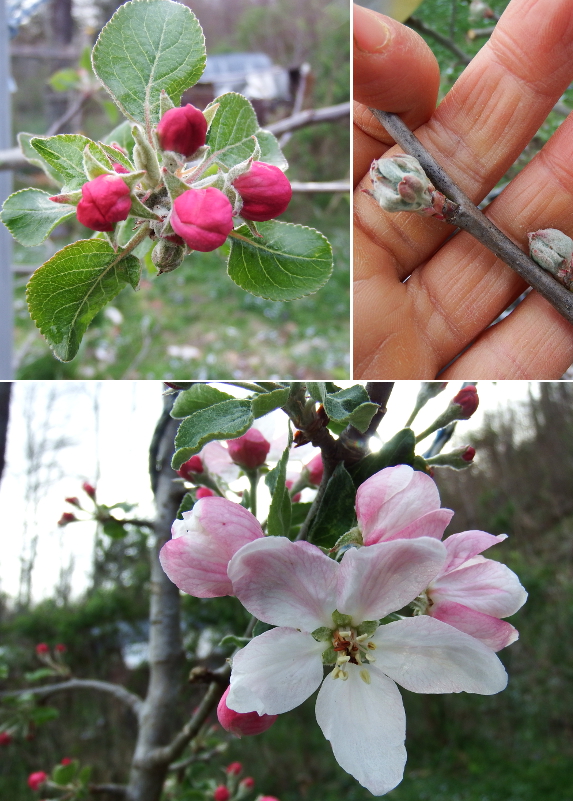
I don't even want to talk
about the hundreds of flowers on our now mature apple trees that are
currently being nipped by this extreme version of dogwood winter. Maybe
the few unopened buds like the ones shown in the upper right in this
photo collage will make it through...but I doubt it. Unfortunately, the
wind has just been too extreme to allow for much freeze protection and
the forecast doesn't look good.
So I'm focusing on what I
can change rather than on what I can't. The weather is beyond my ken,
but location I can handle. To that end, I set out max-min thermometers in two locations that I think have the potential to bypass late spring freezes, or at least to mitigate them a bit.
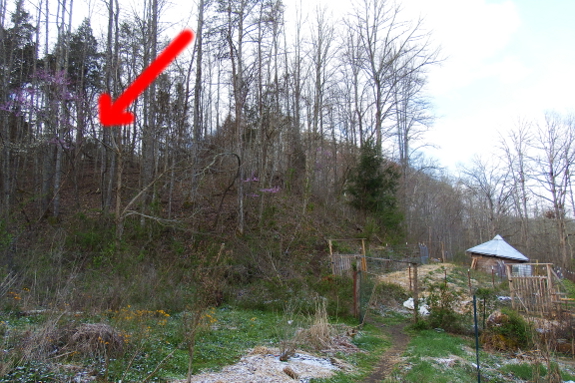
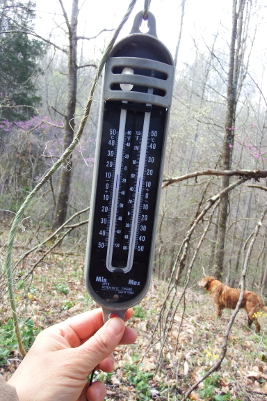 Option
one, shown above, would be my preference. This little knoll is just
above our core homestead, so access is easy (minus the hill climbing).
Old pines have been falling in this area for the last few years, so it
wouldn't be quite so heart-wrenching to take down the forest to make way
for fruit trees. And I can envision that mandatory deer fence butting
up against a goat pasture fence since I dream of someday using most of
this hillside to graze our herd.
Option
one, shown above, would be my preference. This little knoll is just
above our core homestead, so access is easy (minus the hill climbing).
Old pines have been falling in this area for the last few years, so it
wouldn't be quite so heart-wrenching to take down the forest to make way
for fruit trees. And I can envision that mandatory deer fence butting
up against a goat pasture fence since I dream of someday using most of
this hillside to graze our herd.
On the downside, this
knoll is even closer to the north-facing hillside that shades a large
portion of our core homestead than we are. While that location sounds
like it would slow down bud opening in the spring, in my experience
being close to a north-facing hillside just means permafreeze causes
less hardy fruit trees to perish in the dead of winter.
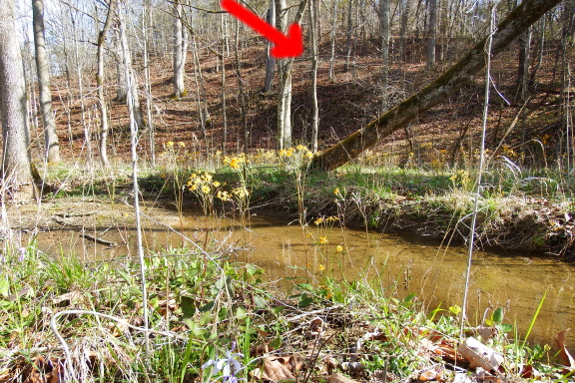
Option two is a little
further away from our core homestead, but is still an easy walk...across
the creek and up the hill. This hillside is south-facing and an old
logging road creates a 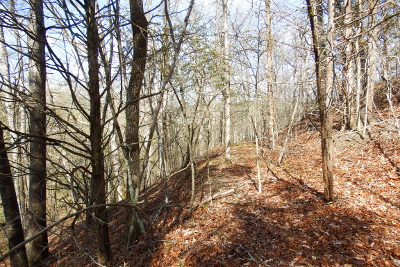 terrace that has been collecting leaves and building humus for decades.
terrace that has been collecting leaves and building humus for decades.
The main disadvantage of
this site is the big, beautiful trees on the south side of the logging
road. It would make me very sad to cut them down, so I'm hoping my
thermometer results will make the pine knoll out to be a better choice
than the logging road. Stay tuned for more data after I check the
thermometers and see if either, both, or neither flew through last
night's deep freeze unscathed.
Want more in-depth information? Browse through our books.
Or explore more posts by date or by subject.
About us: Anna Hess and Mark Hamilton spent over a decade living self-sufficiently in the mountains of Virginia before moving north to start over from scratch in the foothills of Ohio. They've experimented with permaculture, no-till gardening, trailersteading, home-based microbusinesses and much more, writing about their adventures in both blogs and books.
Want to be notified when new comments are posted on this page? Click on the RSS button after you add a comment to subscribe to the comment feed, or simply check the box beside "email replies to me" while writing your comment.

Before you go to all the work of felling trees, possibly leaving the denuded slope open to erosion until the new orchard is established, adding expense for fencing, etc, etc, two questions come to mind:(a) how bad a problem do you have in terms of frequency of late freezes & its impact on harvest, and (2) will a change of location be effective in solving the problem?
While micro-climate is certainly important, this weather pattern we've had this year is unusual, ie- only occurs once every decade or so and sever with temps dipping 15degF below normal. A micro-climate advantage of even 3 or 4degF does you little good when that's still 10degF below freezing.
doc --- Answering question number two is why we're using the thermometers --- I definitely don't want to cut down trees unless we have to. On the other hand, to answer question number one, late spring freezes are why we haven't had apples since 2013, so it's definitely a major problem and I suspect is only going to become worse in the near future. If we're only going to be able to get fruit one year in four within our core homestead using our current methods, a solution is in order.
That said, we're also using some other experimental methods to get around the same problem. I have high hopes for some of these, especially the espalier-along-a-bank. I read recently about people growing figs in rather chilly parts of France by growing them up against stone walls and this would be a similar solution --- thermal mass plus wind break all in one.
Let me share one of my more successful approaches to limiting deer predation: electricity, and LOTS of it!
I live in a really high deer population area. They are unbelievably destructive to fruit trees in multiple ways. The only 'good' thing is that they will quite efficiently find and point out the very sweetest of your orchard varieties. The wood and leaves of these trees seem to be as sweet as their fruit.
I put two steel posts in line with the tree. Post, tree, post. I put the posts about 9-inches away from the tree on both sides. This stops little bucks from scraping off the bark in the fall. I also put electric fence insulators on these posts. I wrap a big loop of fencing wire in a circle around the tree. I have one fencer in a bucket which I move night by night from one tree to another. 'Guess which tree is hot tonight!' The deer are quite quickly trained to stay away from ANY tree which is encircled by fence wire. This also helps keep raccoons out of the trees when the fruit is ready to harvest.
If you're into evil pleasures, wrap aluminum foil swatches over the fence wire and put peanut butter on them. Deer can not leave peanut butter alone, and they pay a huge price for their indulgence - which they do not seem to forget. Peanut butter on hot fence night only!
Good luck!
Hi Tim,
One of the local farms around here does the same thing. Peanut butter on aluminum foil on the electric fence.
Seems to do the trick. They claim that deer can smell the peanut butter at least 2 miles away? And they seem to remember that they got hit.
John
The thermometers are a good idea for getting base numbers recorded. However, I wouldn't rely on them for deciding where to place your new orchard. Because you're measuring elements with existing features. Once you start removing those features, to put in an orchard, the temps will change accordingly. So they aren't going to be an effective tool to make the final decision upon.
I would elect location number one, for several reasons. The first and major reason being, nature is already giving the cues for it. The second location is more stable, which makes it look more attractive as a new orchard site. But once you start using energy to remove the elements which are stabilising that environment - healthy trees - it will become as vulnerable a growing area, as site one, presently is.
I wouldn't want to create more work, destabilising site two. When I could use that same energy to restoring site one. Because nature is already disturbing it. Another reason I would choose site one is, it could create a nutrient loop, between your lower productive areas and the orchard, above. If you loose a lot of nutrients with heavy rainfall, the lower areas will catch what is being leached from the orchard above. Then when your goats feed from the lower area, you can rest the pastures there, by moving them back up the hill to the orchard - returning the nutrients they've eaten, to the top. Then the cycle keeps feeding itself, through gravity plants and herbivores.
But what about the permafrost issues? Would it be possible to sprinkle the batter of the hillside with large to medium sized rocks, Sepp Holzer style? You could grow pumpkins in this location, because they'd appreciate the extra heat in summer. But when they die back in the cooler weather, you can return the dead vines to the orchard above, as mulch. It keeps that nutrient cycle going) and the rocks might help alleviate frosts during winter. Its a theory, I don't know if it would work in your actual location though.
One last reason to choose site one, is proximity to your existing habitable areas. You're more likely to incorporate the orchard into your routine (composting, inspecting, mulching and feeding goats) if its located closer to where you venture most. Which will hopefully benefit the orchard by rejuvenating a destabilised piece of land. Whatever you do on that knoll however, will directly improve what's growing underneath, simply because of nutrient flow and gravity. Site two might be worth contemplating, but for everything site one has going for it, I'd be seeing what I could change on that knoll first, to make it a better growing environment.
You know the area better than I do though, so you'll make the decision that suits best.